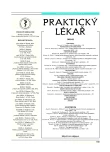Benign cutaneous pigmented lesions and the various possibilities in their examination
Benigní kožní pigmentové projevy, jejich diferenciální diagnostika a možnosti vyšetřování
Sdělení pojednává o melanocytových kožních projevech, které podle základního charakteru dělíme na benigní a maligní. K benigním melanocytovým projevům řadíme melanocytové skvrny (ephelides, kávové skvrny a lentiga, způsobené hyperplazií a hyperfunkcí melanocytů a vlastní melanocytové névy (kongenitální, získané, névus Spitzové, névus modrý a jiné, což jsou hamartomy a benigní nádory. K zhoubným projevům patří maligní melanom. V práci je uvedena zejména diferenciální diagnostika benigních kožních pigmentových projevů.
Klinické vyšetření zkušeným dermatologem zůstává základem péče o pacienty s pigmentovými projevy. Dermatoskopie je neinvazivní vyšetřovací metoda, která zvyšuje diagnostickou jistotu u obtížných případů a omezuje počet zbytečných chirurgických excizí. Digitální varianta dermatoskopie umožňuje sledování pacientů s mnohočetnými a atypickými melanocytovými projevy, porovnávání jednotlivých nálezů s databází a dermatoskopickým atlasem. Digitální analýza dermatoskopického obrazu poskytuje objektivní údaje o tvaru, struktuře a barvě projevů, ale nemůže nahradit zavedený klinický postup u těchto pacientů. Autoři uvádějí základní doporučení vyšetřování pacientů s pigmentovými projevy na kůži.
Klíčová slova:
melanocyt – melanocytové projevy – diferenciální diagnostika – dermatoskopie – digitální dermatoskopie.
Authors:
K. Pizinger; T. Fikrle
Authors‘ workplace:
Dermatovenerologická klinika LF UK a FN, Plzeň
přednosta prof. MUDr. V. Resl, CSc.
Published in:
Prakt. Lék. 2005; 85(4): 202-206
Category:
Of different specialties
Overview
Melanocytic cutaneous neoplasms could be basically divided into benign and malignant lesions. The former are melanotic spots (freckles, lentigo, etc. which are caused by hyperfunction and hyperplasia of melanocytes), and melanocytic nevi (congenital, common acquired, Spitz, blue nevi, etc. which are hamartomas and benign tumours). The latter are malignant melanomas. We give notice of nonmelanocytic lesions in the differential diagnosis of melanoma. The clinical examination by experienced dermatologists is still the basic diagnostic method in patients with pigmented skin lesions. Dermatoscopy is a noninvasive second-step procedure which increases the diagnostic certainity in difficult cases and reduces the number of needless surgical excisions. The digital version of dermatoscopy makes the high-quality follow-up of patients with multiple or atypical melanocytic lesions posssible, it also enables the comparison of actual dermatoscopic images with other lesions from a database or atlas. Digital analysis of dermatoscopic images provides objective information about the geometric, structural and color characteristics of the lesion. The results of digital analysis cannot replace the clinical examination of patients with melanocytic lesions. We describe the basic recommendations for the examination of patients with pigmented skin lesions.
Key words:
melanocyte – melanocytic lesions – differential diagnosis – dermatoscopy – digital dermatoscopy.
Labels
General practitioner for children and adolescents General practitioner for adultsArticle was published in
General Practitioner

2005 Issue 4
- Hope Awakens with Early Diagnosis of Parkinson's Disease Based on Skin Odor
- Memantine Eases Daily Life for Patients and Caregivers
- Spasmolytic Effect of Metamizole
- Metamizole vs. Tramadol in Postoperative Analgesia
- Metamizole at a Glance and in Practice – Effective Non-Opioid Analgesic for All Ages
Most read in this issue
- The aggressive patient
- Benign cutaneous pigmented lesions and the various possibilities in their examination
- Musculoskeletal complaints at work with the computer
- Genetics and ethics – past, present, and future
